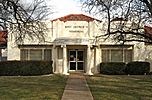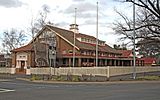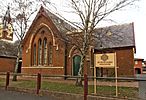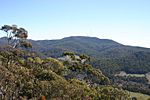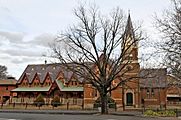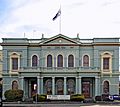Orange, New South Wales facts for kids
Quick facts for kids OrangeNew South Wales |
|||||||||||||||
|---|---|---|---|---|---|---|---|---|---|---|---|---|---|---|---|
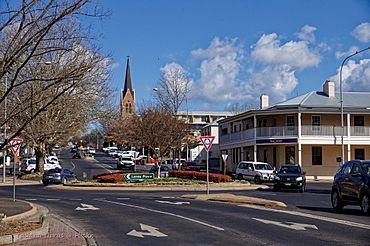
Byng Street
|
|||||||||||||||
| Population | 40,493 (2018) (10th in NSW) | ||||||||||||||
| Established | 1846 | ||||||||||||||
| Postcode(s) | 2800 | ||||||||||||||
| Elevation | 863.2 m (2,832 ft) | ||||||||||||||
| Location | |||||||||||||||
| LGA(s) | City of Orange | ||||||||||||||
| Region | Central West | ||||||||||||||
| County | Wellington, Bathurst | ||||||||||||||
| State electorate(s) | Orange | ||||||||||||||
| Federal Division(s) | Calare | ||||||||||||||
|
|||||||||||||||
|
|||||||||||||||
Orange is a city in the Central Tablelands region of New South Wales, Australia. It is 254 km (158 mi) west of the state capital, Sydney [206 km (128 mi) on a great circle], at an altitude of 862 metres (2,828 ft). Orange had an estimated urban population of 40,493 as of June 2018 making the city a significant regional centre. A significant nearby landmark is Mount Canobolas with a peak elevation of 1,395 m (4,577 ft) AHD and commanding views of the district. Orange is situated within the traditional lands of the Wiradjuri Nation.
Orange is the birthplace of poets Banjo Paterson and Kenneth Slessor, although Paterson lived in Orange for only a short time as an infant. Walter W. Stone, book publisher (Wentworth Books) and passionate supporter of Australian literature, was also born in Orange. The first Australian Touring Car Championship, known today as V8 Supercar Championship Series, was held at the Gnoo Blas Motor Racing Circuit in 1960.
Contents
History
In 1822 Captain Percy Simpson marched into the Wellington District and established a convict settlement which was called "Blackman's Swamp" after James Blackman; Simpson had employed James Blackman as a guide because he had already accompanied an earlier explorer, John Oxley into that region.
In the late 1820s, the surveyor J. B. Richards worked on a survey of the Macquarie River below Bathurst and also of the road to Wellington. On a plan dated 1829, he indicated a village reserve, in the parish of Orange. Sir Thomas Mitchell named the parish Orange, as he had been an associate of the Prince of Orange in the Peninsular War, when both were aides-de-camp to the Duke of Wellington, whose title was bestowed on the valley to the west by Oxley.
Initial occupation by British graziers began in late 1829, and tiny settlements eventually turned into larger towns as properties came into connection with the road. In 1844, the surveyor Davidson was sent to check on encroachments onto the land reserved for a village, and to advise on the location for a township. His choices were Frederick's Valley, Pretty Plains, or Blackman's Swamp.
Blackman's Swamp was chosen, and it was proclaimed a village and named Orange by Major Thomas Mitchell in 1846 in honor of Prince William of Orange. At nearby Ophir, a significant gold find in Australia was made in 1851, resulting in a sporadic population movement which is known as the Australian gold rush. Additional gold finds in nearby areas led to the establishment of Orange as a central trading centre for the gold.
The growth of Orange continued as the conditions were well suited for agriculture, and in 1860 it was proclaimed a municipality. The railway from Sydney reached Orange in 1877. In 1946, 100 years after it was first being established as a village, Orange was proclaimed as a minor city.
Suburbs
The following are listed as the suburbs within Orange City Council, according to the New South Wales Division of Local Government:
- Ammerdown: a residential locality to the north west of Orange on the Mitchell Highway.
- Bletchington: containing mostly residential areas with one school, it is one of the largest residential areas, and it is often split into North Orange and Bletchington. Within the suburb are the Orange Botanic Gardens, the Orange Adventure Playground, and the Waratah Sports Ground.
- Bloomfield: containing farmland, Bloomfield Golf Course, Riverside Mental Institution and Orange Health Service (a major regional hospital) along with the Gosling Creek Reservoir and the Gosling Creek nature reserve.
- Borenore: a locality, 15 km (9 mi) west of Orange, comprising primarily farmland. Also the site of the Australian National Field Days.
- Bowen: containing residential, predominantly public housing, industrial, commercial, Kinross Woloroi School, and government offices, this suburb also has the main road out of Orange to Sydney. It also contains the Orange Showground and the Orange Cemetery.
- Calare: the suburb is located to the west of the CBD. It is mostly a residential area, and contains Calare Public School and Orange High School, and Wentworth Golf Course. It is also commonly split into Calare, Bel-Air and Wentworth Estate and has The Quarry and Towac Park Racecourse. It houses most New Areas of Orange
- Canobolas: this mainly farming and recreation area, contains the Mount Canobolas State recreation area and Mount Canobolas.
- Clifton Grove: containing farmland and large residential blocks, some parts of the estate are down stream from the Suma Park Reservoir and the area also contains the Kinross State Forest.
- Clover Hill: a residential suburb to the north of the CBD.
- Glenroi: a mainly residential area with areas of public housing, along with the Electrolux white goods manufacturing plant. It also contains industrial land in areas surrounding the factory, as well as a more recent industrial area known as Leewood Estate.
- Huntley: a locality south of Orange.
- Lucknow: a small village approximately 9 kilometres (5.6 mi) east of Orange. It is a historic mining town with small residential, small industrial and commercial with most being farmland.
- March: a locality north of Orange.
- Millthorpe: a village south east of Orange. The area constituting a suburb of Orange is constituted of farmland lying to the north west of the village.
- Narrambla: a mainly industrial and farming land area.
- Nashdale: a small but vibrant community located approximately 8 kilometres west of Orange. The community gathers around the local Nashdale Public School and hall. Rich producer of local food and wine.
- Orange: the suburb comprises the central business district of the city, which contains an original grid street plan. The main street of Orange is Summer Street. The CBD can be defined as being the area of the city bounded by Hill, March, Peisley, and Moulder Streets.
- Orange East: beginning on the eastern side of the railway line, Orange East is mostly residential, but contains some light businesses, especially on Summer, Byng, and Willams Streets.
- Orange South: directly to the south of the CBD, beginning past Moulder Street this area contains Wade Park and the Orange Base Hospital.
- Shadforth: a locality to the east of Orange bypassed by the Mitchell Highway that contains Shadforth Quarry.
- Spring Hill: a village to the south-east of Orange.
- Spring Terrace: a locality and small village located south of Orange, centred on the local primary school.
- Springside: a locality to the south of Orange.
- Suma Park: a lightly populated residential area on the eastern outskirts of Orange. It contains Suma Park Reservoir, Orange's main water supply.
- Summer Hill: a lightly populated residential, industrial, and farmland area on the south eastern outskirts of Orange on the Mitchell Highway.
- Warrendine: a mostly residential area with a high school and industrial land. It also has small school farmland and Jack Brabham Park.
Climate
Orange has a mild temperate climate with warm summers and cool winters, and with rainfall distributed fairly evenly throughout the year. Under the Köppen climate classification scheme, it has a moderate oceanic climate (Cfb) with subtropical highland (Cwb) influences, due to its elevation. Compared with most population centres in Australia it has colder winters, especially in terms of its daytime maximum temperatures. In summer, the average (and absolute) maximum temperatures are also lower than in most inland centres, on account of its elevation. The climate has enabled the area to be a major apple and pear producer, and more recently a centre for cool-weather wine production.
Owing to its inland location, the humidity is low in the summer months with the dewpoint typically around 10 °C. Having 99.8 clear days annually, it is still cloudier than the coastal areas of Sydney and Wollongong (104 and 107 clear days, respectively). Additionally, it is one of the only cities in Australia to receive regular snow, with moderate to occasionally heavy snowfalls occurring several times each winter. Its claim as Australia's snowiest city is sometimes disputed by Ballarat in Victoria and nearby Lithgow.
| Climate data for Orange Airport | |||||||||||||
|---|---|---|---|---|---|---|---|---|---|---|---|---|---|
| Month | Jan | Feb | Mar | Apr | May | Jun | Jul | Aug | Sep | Oct | Nov | Dec | Year |
| Record high °C (°F) | 37.4 (99.3) |
40.1 (104.2) |
33.0 (91.4) |
29.8 (85.6) |
22.0 (71.6) |
18.5 (65.3) |
17.8 (64.0) |
20.4 (68.7) |
25.6 (78.1) |
30.7 (87.3) |
35.6 (96.1) |
35.0 (95.0) |
40.1 (104.2) |
| Average high °C (°F) | 26.0 (78.8) |
25.2 (77.4) |
22.4 (72.3) |
18.3 (64.9) |
13.9 (57.0) |
10.4 (50.7) |
9.3 (48.7) |
10.7 (51.3) |
13.7 (56.7) |
17.3 (63.1) |
20.5 (68.9) |
23.9 (75.0) |
17.6 (63.7) |
| Average low °C (°F) | 12.2 (54.0) |
12.3 (54.1) |
9.6 (49.3) |
6.2 (43.2) |
3.6 (38.5) |
1.5 (34.7) |
0.7 (33.3) |
1.4 (34.5) |
3.3 (37.9) |
5.8 (42.4) |
7.9 (46.2) |
10.1 (50.2) |
6.2 (43.2) |
| Record low °C (°F) | 1.7 (35.1) |
2.4 (36.3) |
−0.5 (31.1) |
−3.5 (25.7) |
−6.6 (20.1) |
−6.5 (20.3) |
−7.1 (19.2) |
−5.8 (21.6) |
−6.0 (21.2) |
−3.0 (26.6) |
−1.0 (30.2) |
−1.0 (30.2) |
−7.1 (19.2) |
| Average precipitation mm (inches) | 84.0 (3.31) |
82.4 (3.24) |
53.7 (2.11) |
52.6 (2.07) |
62.5 (2.46) |
66.2 (2.61) |
88.2 (3.47) |
93.6 (3.69) |
79.0 (3.11) |
78.2 (3.08) |
76.0 (2.99) |
78.8 (3.10) |
895.1 (35.24) |
| Average rainy days | 8.7 | 8.2 | 7.2 | 7.2 | 10.1 | 12.4 | 13.7 | 13.5 | 11.6 | 10.8 | 10.3 | 9.0 | 122.7 |
| Average relative humidity (%) | 44 | 49 | 51 | 55 | 63 | 70 | 70 | 65 | 61 | 56 | 53 | 45 | 57 |
Mining
Cadia-Ridgeway Mine is a large open cut gold and copper mine located about 20 kilometres south of Orange, the mine has been developed throughout the 1990s employing several thousand employees with an expected lifespan of several decades. Cadia is the second largest open cut mine in Australia after the Super Pit at Kalgoorlie. Large mineral deposits are also being uncovered from the more recently developed Ridgeway underground mine which is adjacent to the Cadia Mine.
The mine is operated by Newcrest Mining. Cadia-Ridgeway is one of two gold mines Newcrest currently operates in Australia, the other being Telfer in Western Australia. The company also owns and operates the Gosowong Mine in Indonesia and the Lihir mine in Papua New Guinea (both gold mines) amongst others .
Transport
Roads
Orange is situated on the Mitchell Highway, linking the city to Molong, Wellington, Dubbo and Bourke to the north west, and to Bathurst to the east and from there to Sydney via the Great Western Highway (260 km or 160 mi). Due west are Parkes (100 km or 62 mi) and Forbes (125 km or 78 mi), which is midway along the Newell Highway, running from Brisbane, Queensland to Melbourne, Victoria. In 2007 a bypass road, known as the northern distributor road, was opened for use after decades of planning.
Public transport
Orange Buslines operate a number of routes within the city and a service to the neighbouring city of Bathurst. Newman's Bus Service operates route two on weekdays to Blayney. Australia Wide Coaches operate a daily coach service to Sydney.
NSW TrainLink operate several coach services with connecting train services from Lithgow to Sydney, as well as a less frequent coach service to Cootamundra for connection to Melbourne.
Air
Orange is also serviced by a regional-class airport, Orange Airport, located approximately 15 km to the south of the city, in an area known as Huntley.
Railways
Orange has two railway stations. The main station, on the Main Western Line to Bourke, was opened in 1877 and is served by the daily NSW TrainLink Central West XPT service between Sydney and Dubbo and the weekly Outback Xplorer service between Sydney and Broken Hill. A smaller station, opened in 1970, known as Orange East Fork, lies on the branch line to Broken Hill was served by the weekly Indian Pacific service to Perth but due to low passenger numbers using this station (16 for the entire year 2017) this "bare bones" station is no longer used and the Indian-Pacific no longer stopping between Mt. Victoria and Broken Hill.
Sister cities
Orange is a sister city to:
 Orange, California, United States (1963)
Orange, California, United States (1963) Ushiku, Japan (1990)
Ushiku, Japan (1990) Mount Hagen, Papua New Guinea (1985)
Mount Hagen, Papua New Guinea (1985) Timaru, New Zealand (1986)
Timaru, New Zealand (1986)
Attractions
- Anzac Park
- Borenore Caves
- Cadia Mine
- Cook Park
- 25 Cellar Doors
- Duntryleague Golf Club and Clubhouse
- Federal Falls
- Gnoo Blas Race Circuit Area
- Hill End
- Historic Centre of Orange
- Lake Canobolas
- Lucknow Historic Village
- Mount Canobolas lookout
- Ophir
- Orange Botanic Gardens
- Orange Heritage Trail
- Orange indoor and outdoor Aquatic centre
- Orange Regional Art Gallery
- Narrambla, the birthplace of Banjo Paterson
- Robertson Park
- The Pinnacle lookout
- Towac Valley
- Wade Park
Clubs in Orange
- Orange City Bowling Club
- Orange Ex-Services Club
- Orange Rifle Club
- Goldseekers Orienteering Club
- Waratah Sports Club
- DuntryLeague Golf Club
Historic Orange buildings
- Anson House
- Australia Cinema
- Bowen Terrace
- Centrepoint Arcade Building
- Cook Park Greenhouses and caretakers houses
- Dalton Bros Buildings (Myer Building)
- Hotel Canobolas (a fine example of Art-Deco style, erected 1939)
- Hotel Orange
- Holy Trinity Anglican Church
- Memorial Hall
- Metropolitan Hotel
- Orange Court House
- Orange Fire Station
- Orange Post Office
- Orange Public School
- Orange Town Hall
- Royal Hotel
- Saint Joseph's Church
- Scout Hall
- The former Strand Theatre
- Wyoming Court
Historic houses
- Strathroy Manor
- Duntryleague House
- Kangaroobie Mansion
- Croagh Patrick
- Woloroi House
- Galbally
- Killenny
- Mena
- Ammerdown House
- Glenroi House (no longer standing, demolished for McDonald's)
Gallery
Education
Primary and public schools
|
|
|
The following primary schools are not within the city limits of Orange but are located within the rural fringe of Orange:
|
|
|
Secondary schools
- Orange High School
- James Sheahan Catholic High School
- Canobolas Rural Technology High School
- Orange Christian School (K–12)
- Kinross Wolaroi School (Prep–12)
- Orange Anglican Grammar School (Transition 4yrs – 12)
- MET School Orange Campus (3–12)
- De La Salle College (defunct)
Tertiary education
- A campus of Charles Sturt University is located on the outskirts of northern Orange.
- A large campus of TAFE is also located in Orange.
- Orange Regional Conservatorium
Notable residents
Architecture
- John Andrews AO - internationally acclaimed architect resides in the city
- John Blackwood, 11th Baron Dufferin and Claneboye, is an architect who for most of his career practised in Orange.
Business
- James Dalton (1834–1919), an early Australian merchant, pastoralist, and Roman Catholic lay leader, a key figure in the early development of Orange and district
Film and television
- Billy Bevan (1887–1957), actor, born William Bevan Harris in Orange.
- Mark Furze, a television actor and singer, born in Orange in 1986.
- Elizabeth Lackey, an actress and model, attended Orange High School in the 1980s.
Food and hospitality
- Kate Bracks, winner of the third series of MasterChef Australia, from Orange
Medicine
- Janet Carr, physiotherapist and academic, raised in Orange
- Anna Windsor (born 1976), Multi Olympian and Commonwealth Games swimmer. Medical Doctor based in Orange.
Music and creative arts
- Murray Cook, a vocalist, songwriter and guitarist; best known as one of the members of The Wiggles, grew up in Orange
- Susan, Crown Princess of Albania (1941–2004), the wife of Leka, Crown Prince of Albania, educated and taught art at Presbyterian Ladies College, Orange
- Shannon Noll, a singer; best known for the song ‘What About Me?’, was born in Orange.
Poetry
- Banjo Paterson (1864–1941), poet, born near Orange
- Kenneth Slessor (1901–1971), poet, born in Orange
Sports
- Robbie Abel, professional rugby union footballer, born in Orange in 1989
- Jason Belmonte, professional tenpin bowler, born in Orange in 1983
- Edwina Bone, professional hockey player for Australia, was born in Orange
- Darren Britt, former professional rugby league footballer, born in Orange in 1969
- Tino Fa'asuamaleaui, Professional rugby league player, born in Orange in 2000
- Adam Clune, professional rugby league player, born in Orange in 1995
- Andrew Dawes, Australian Paralympic coach, born in Orange in 1969
- Jo Garey, Australian cricketer 1995, lives in Orange.
- Bob Lindfield, professional rugby league player, born in Orange in 1901
- David Lyons, professional rugby union player, born in Orange in 1980
- Phoebe Litchfield, Australian cricketer, lives in Orange.
- James Maloney, professional rugby league player, born in Orange in 1986
- Ted McFadden born in Orange 1880 played in the inaugural Balmain Tigers Rugby League Team (1908–1910)
- Daniel Mortimer, professional rugby league player, born in Orange in 1989
- Peter Mortimer, father of Daniel Mortimer, a former professional rugby league footballer and manager, now news reporter and winery owner, living in the Orange region
- Lucas Parsons, professional golfer, born in Orange in 1969
- Jack Wighton, professional rugby league player, born in Orange in 1993
Images for kids




